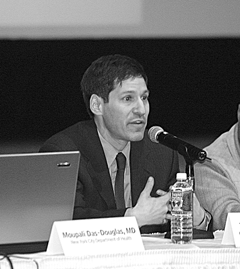City health department says it has tracked “related,” but not “identical,” strains of virus
Six weeks after it announced a single case of a gay New York City man who was infected with multi-drug resistant HIV and had rapidly progressed to AIDS, the city health department has found no other cases.
“As of today, no other cases of multi-drug class-resistant, rapidly progressive HIV have been identified,” the department said in a March 29 statement. “To date, no other patients have been identified with the same strain.”
The department has contacted “most” of the sex partners the man identified and many were “previously HIV-infected,” according to the statement.
Blood samples from the sex partners are being tested to determine the “genetic relatedness” of the HIV that infects the gay man and his sex partners. That testing could take “weeks to months,” the department said.
The department noted that the “source of the New York City man’s infection is still unknown and remains under investigation” as does the “extent to which this strain has spread.”
In addition to contacting the man’s sex partners, the department wrote to physicians and to 39 labs around the country that do HIV testing, including HIV drug resistance testing, asking them to report any cases.
“Laboratories have identified several patients whose strains may be related to this patient’s strains,” the statement said. “However, database matching and laboratory analysis of these strains is complex and we do not expect to have results of genetic analyses of these strains for weeks or months. No patients with identical strains have been identified.”
It is not clear what “related” means, since all HIV could be said to be related, and the department did not respond to a request for clarification of that term.
The statement said that the man is getting effective treatment. Earlier lab testing had indicated that the man’s virus was resistant to all of the drugs in two of four classes of anti-HIV drugs with susceptibility to some drugs in the other two classes.
“Although the patient’s strain of HIV is highly drug resistant, the patient is responding to treatment thus far that includes the two drugs to which his strain appears to be susceptible, as well as other drugs which may be effective,” the statement said.
At a March 3 town meeting, Dr. Lawrence G. Hitzeman, an attending physician at Cabrini Medical Center who has spoken with the man’s doctor, said that the man’s viral load, a measure of the amount of virus in his blood, went from more than 600,000 to 4,000 after being treated with four AIDS drugs.
Hitzeman told Gay City News that the drop was “significant,” but it could take three to six months to determine if his response to treatment is “durable.”
The man’s T cell count, a measure of his immune systems health, is still very low at 48, Hitzeman said.
A normal T cell count ranges from 700 to 1,200.
The February 11 announcement came out of concern that the New York City man may have infected others or the man who infected him may have infected others raising the prospect of an outbreak of multi-drug resistant HIV that causes rapid progression. The New York City man had many sex partners and had used crystal for years.
AIDS activists and researchers, who criticized the announcement as lacking a solid scientific basis, found justification for their charges in the March 29 update—the man is responding to treatment and, to date, he remains the only person known to be infected with this specific strain of virus.
“They seem to be finding out the hard way that they’ve made a bunch of erroneous assumptions about the underlying science,” wrote Richard Jefferys, basic science project director at the Treatment Action Group, a New York City AIDS organization, in an e-mail message. “Whatever real concerns they may have wanted to raise about unsafe sex and crystal are likely to be undermined by the fact that they’ve pegged them onto a story that is not rooted in science, but science fiction.”
Julie Davids, executive director of the Community HIV/AIDS Mobilization Project (CHAMP), also based in New York, said the March 29 update had a quieter tone and it discussed such things as HIV testing and counseling.
“This is much more measured and pulls back from the hysteria as many predicted it would,” she said. “I also think there are many things in here that they could have said back then that would have been useful.”
For one researcher, the department seemed to be backing away from its earlier posture that it was presented with a threat that required an immediate response.
“It’s basically saying ‘We don’t have anything to say, stop calling us, we’ll call you,’” said Dr. John P. Moore, professor of microbiology and immunology at the Weill Medical College of Cornell University. “If one is trying to be fair to them, it does take time to do all the appropriate genetic and virologic tests. I wouldn’t have expected a final answer on this subject by now anyway.”
gaycitynews.com



































